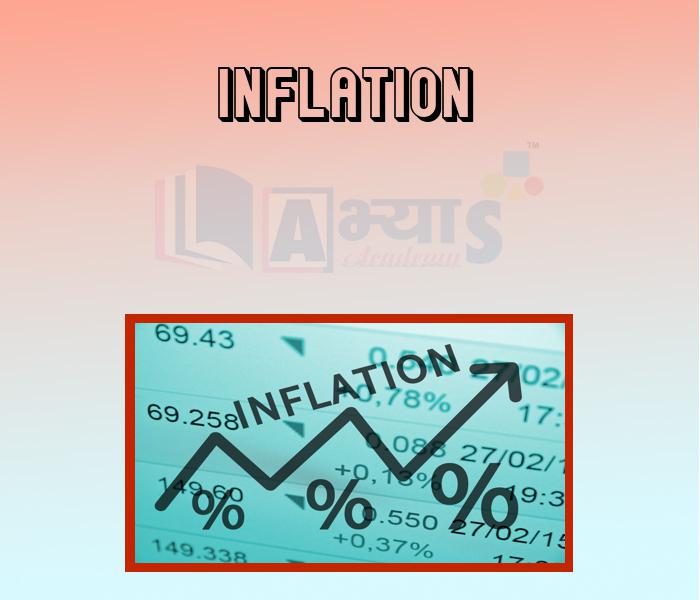Inflation











Inflation
Inflation :
It is the rate at which the general level of prices for goods and services is rising and subsequently purchasing power is falling. Inflation is defined as a sustained increase in the general level of prices for goods and services. It is measured as an annual percentage increase. As inflation rises, every rupee you own buys a smaller percentage of a good or service.
The value of a rupee does not stay constant when there is inflation. The value of a rupee is observed in terms of purchasing power, which is the real, tangible goods that money can buy. When inflation goes up., there is a decline in the purchasing power of money. For example, if the inflation rate is 2% annually, then theoretically a Re 1 pack of gum will cost Rs. 1.02 in a year. After inflation, your money can't buy the same amount of goods it could beforehand.
Stages Of Inflation
Causes Of Inflation
Factors responsible for inflation:
On the Basis of Demand
1.Increase in nominal money supply
2. Increase in disposable income
3. Expansion of credit
4. Deficit financing policy
5.Black money spending
6. Repayment of public debts
7. Expansion of the private sector On the Basis of Supply
1. Shortage of factors of production or inputs
2. Natural calamities
3. Artificial scarcities
4.Increase in exports (excess exports)
5. Neglecting the production of consumer goods
Effects of Inflation on Economy :
1. When the balance between supply and demand goes out of control, consumers could change their buying habits, forcing manufacturers to cut down production.
2. Inflation can create major problems in the economy. Price increase can worsen the poverty,affecting low income household.
3. Inflation creates economic uncertainty and is a dampener to the investment climate, slowing growth and finally reducing savings and thereby consumption.
4. The producers would not be able to control the cost of raw material and labour, and hence, the price of the final product. This could result in less profit or in some extreme case no profit, forcing them out of business.
5. Manufacturers would not have an incentive to invest in new equipment and new technology.
6. Uncertainty would force people to withdraw money from the bank and convert long lasting value like gold, artifacts, etc
Students / Parents Reviews [10]
Abhyas is a complete education Institute. Here extreme care is taken by teacher with the help of regular exam. Extra classes also conducted by the institute, if the student is weak.

Om Umang
10thIt has a great methodology. Students here can get analysis to their test quickly.We can learn easily through PPTs and the testing methods are good. We know that where we have to practice

Barkha Arora
10thAbhyas Methodology is very good. It is based on according to student and each child manages accordingly to its properly. Methodology has improved the abilities of students to shine them in future.

Manish Kumar
10thBeing a parent, I saw my daughter improvement in her studies by seeing a good result in all day to day compititive exam TMO, NSO, IEO etc and as well as studies. I have got a fruitful result from my daughter.

Prisha Gupta
8thIt was a good experience with Abhyas Academy. I even faced problems in starting but slowly and steadily overcomed. Especially reasoning classes helped me a lot.

Cheshta
10thI have spent a wonderful time in Abhyas academy. It has made my reasoning more apt, English more stronger and Maths an interesting subject for me. It has given me a habbit of self studying

Yatharthi Sharma
10thAbout Abhyas metholodology the teachers are very nice and hardworking toward students.The Centre Head Mrs Anu Sethi is also a brilliant teacher.Abhyas has taught me how to overcome problems and has always taken my doubts and suppoeted me.

Shreya Shrivastava
8thIt was good as the experience because as we had come here we had been improved in a such envirnment created here.Extra is taught which is beneficial for future.

Eshan Arora
8thA marvelous experience with Abhyas. I am glad to share that my ward has achieved more than enough at the Ambala ABHYAS centre. Years have passed on and more and more he has gained. May the centre flourish and develop day by day by the grace of God.

Archit Segal
7thOne of the best institutes to develope a child interest in studies.Provides SST and English knowledge also unlike other institutes. Teachers are co operative and friendly online tests andPPT develope practical knowledge also.
